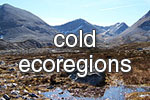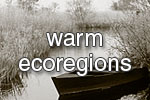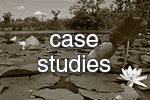Wetlands in cold ecoregions - overview
The pristine status
Wetlands are among the most abundant and biologically productive aquatic ecosystems in the Arctic, and occur most commonly as marshes, bogs, fens, peatlands, and shallow open waters. Wetlands in high latitudes and mountainous regions are predominantly ‘mires’, characterised by the accumulation of peat. These unique systems support highly adapted plants and animals, notably a wide range of carnivorous plant species. Arctic wetlands are highly productive and diverse systems, as they often are important transition zones between uplands and more permanent freshwater and marine water bodies. They are typically dominated by hydrophytic vegetation, with a few species of mosses and sedges, and in some instances terrestrial species such as lichens, shrubs, and trees. Many peatlands in high latitudes are important for breeding and migratory birds, fish, and mammals such as reindeer and rodents, which support predator populations. In Sweden, wet forests and bogs provide habitat for about 200 threatened species of plant and animal. Aside from habitat provision, river-flow attenuation, and a number of other ecological functions, wetlands also store and potentially release a notable amount of carbon, with potential positive feedbacks to climate change
Rain-fed rivers, wholly dependent on atmospheric inputs for their water and solute supplies, also develop in regions having adequate precipitation. Fen peats develop in sites fed by groundwater, which may be on slopes, in basins, or on river floodplains and lake margins. Some peatlands are extensively forested.
Human impact
Peat-dominated wetlands have been altered by a wide range of impacts, including natural drying of the peat mass beyond its ability to retain a high water table, effects of acid rain and eutrophication, drainage for forestry and agriculture, and mining by the peat industry for energy and horticultural products.
Climate change impact
 Click to enlarge Warmer climates will likely result in more precipitation in general and less precipitation falling as snow in high northern latitudes, altering the hydrology of streams and rivers. Rivers in the southern parts of the boreal zone with catchments lacking large alpine areas will experience significant decreases in the proportion of precipitation falling as snow. In these systems spring floods will have lower magnitudes or disappear, resulting in losses or reductions in the area of riparian forest communities, with subsequent losses in riparian species richness. In addition, water levels will vary less among seasons, with higher winter flows, resulting in upward displacements of low-elevation riparian zonation, amphibious and aquatic plant communities replacing forbs and graminoids. In boreal continental-climate regions, warming is expected to lead to more extreme summer humidity deficits, resulting in decreased summer flows and more drought stress, which may reduce riparian biomass production and alter competitive relations among species. Increases in the occurrence of extreme floods of long duration can cause extinctions of flood-sensitive species.
Click to enlarge Warmer climates will likely result in more precipitation in general and less precipitation falling as snow in high northern latitudes, altering the hydrology of streams and rivers. Rivers in the southern parts of the boreal zone with catchments lacking large alpine areas will experience significant decreases in the proportion of precipitation falling as snow. In these systems spring floods will have lower magnitudes or disappear, resulting in losses or reductions in the area of riparian forest communities, with subsequent losses in riparian species richness. In addition, water levels will vary less among seasons, with higher winter flows, resulting in upward displacements of low-elevation riparian zonation, amphibious and aquatic plant communities replacing forbs and graminoids. In boreal continental-climate regions, warming is expected to lead to more extreme summer humidity deficits, resulting in decreased summer flows and more drought stress, which may reduce riparian biomass production and alter competitive relations among species. Increases in the occurrence of extreme floods of long duration can cause extinctions of flood-sensitive species.
For further reading
- Ström L., Jansson R., Nilsson C., Johansson M.E. & Xiong S.J. (2011) Hydrologic effects on riparian vegetation in a boreal river: an experiment testing climate change predictions. Global Change Biology, 17, 254–267.
link to article - Ström et al., 2012. Projected changes in plant species richness and extent of riparian vegetation belts as a result of climate-driven hydrological change along the Vindel River in Sweden. doi:10.1111/j.1365-2427.2011.02694.x
link to article









